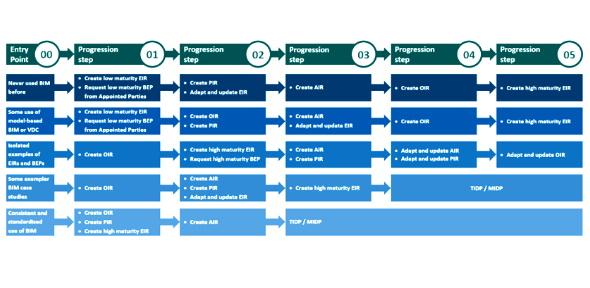
Submitted by Simone Castello on Tue, 23/11/2021 - 09:57
PRESS RELEASE
On Wednesday, 24 November 2021 - during Digital Construction Week - CDBB International launches a new BIM Toolkit to support the adoption and implementation of BIM across the globe. The international BIM Toolkit has been created following collaborative work led by CDBB International, supporting the UK Government’s Prosperity funded Global Infrastructure Programme (GIP).
Since 2018, CDBB’s International team has been working with government officials and industry stakeholders in partner countries across Latin America and Asia to identify the adaptations required for BIM implementation to meet local cultural, contractual and legal conditions and, importantly, to deliver on the desired national outcomes for each country. This international initiative brought together the Foreign Commonwealth and Development Office (FCDO), the Department for Business, Energy & Industrial Strategy (BEIS) and the Infrastructure and Projects Authority (IPA) to foster infrastructure development that helps the partner countries to improve their economic, environmental and social conditions.
What is the BIM Toolkit?
The International BIM Toolkit was formed to address a knowledge gap observed at international level of having a set of tools for introducing Building Information Modelling (BIM) to public procurement practices and project delivery. The Toolkit is a set of guidance and template documents, aligned with the ISO 19650 series of standards and comprises key components facilitating implementation of best-practice information management processes, for organisations at every level of BIM adoption. The overall aim is to support different countries with the creation of their technical BIM framework.
Mike Turpin, Technical Advisor to CDBB International, explained: “Many countries and organisations across the world are still developing and refining their BIM strategies. Whilst there are many reasons and benefits to adopting BIM, which can vary by geography, organisational preferences or project requirements, the most common drivers for BIM are efficiency and standardisation. The international BIM Toolkit helps to support both drivers by providing a consistent, common foundation to some of these key BIM documents.”
Adam Matthews, Head of CDBB’s International Programme, said: “The BIM Toolkit is a huge boost to those starting out on their BIM journey, taking away some of the initial project setup barriers to BIM adoption. Likewise, the Toolkit is useful to those already several steps along their BIM adoption journey, providing additional examples of documentation and references to industry best practice and standardisation. The BIM Toolkit will help to level the playing field internationally and improve consistency.”
This collection of knowledge products is the culmination of input from over 200 contributors over a three-year collaboration period. The Toolkit is freely available and can be downloaded from the CDBB’s website here.
***ENDS***
Resources and further reading
- What is BIM? Explore digital ways of working
- Why BIM? How BIM can benefit public buildings and infrastructure
Editor’s Notes
If you are based in the UK and are looking for support to implement Building Information Modelling (BIM) please visit the UK BIM Framework which sets out the overarching approach for implementing BIM in the UK using the framework for managing information provided by the ISO 19650 series.
Definitions
BIM – Building Information Modelling (BIM) is the “use of a shared digital representation of a built asset to facilitate design, construction and operation processes to form a reliable basis for decisions” (BS EN ISO 19650-1:2018). BIM facilitates early supply chain and operational team involvement. Furthermore, it unlocks more efficient and transparent ways of planning, designing, creating and maintaining built assets, whether buildings or infrastructure, over their whole lifecycle.
About CDBB
CDBB (Centre for Digital Built Britain) is a partnership between the Department for Business, Energy & Industrial Strategy and the University of Cambridge. It is also a partner in the Construction Innovation Hub. CDBB seeks to understand how the construction and infrastructure sectors could use a digital approach to better design, build, operate, integrate the built environment. A digital built Britain will:
- understand what information is needed to enable better through life economic, social and environmental value from our built environment;
- champion human-centric design of infrastructure and the services they deliver;
- exploit new and emerging digital construction and manufacturing skills and technology to reduce costs and increase productivity;
- grow new career, business and export opportunities for the UK.
For more information, visit www.cdbb.cam.ac.uk
About the Foreign, Commonwealth & Development Office (FCDO)
The FCDO pursues our national interests and projects the UK as a force for good in the world. We promote the interests of British citizens, safeguard the UK’s security, defend our values, reduce poverty and tackle global challenges with our international partners. For more information, visit https://www.gov.uk/government/organisations/foreign-commonwealth-development-office
About the Department for Business, Energy and Industrial Strategy (BEIS)
The Department for Business, Energy & Industrial Strategy (BEIS) brings together responsibilities for business, industrial strategy, science, innovation, energy, and climate change. For more information, visit https://www.gov.uk/government/organisations/department-for-business-energy-and-industrial-strategy
About the Infrastructure and Projects Authority (IPA)
The Infrastructure and Projects Authority (IPA) supports the successful delivery of all types of major projects; ranging from railways, schools, hospitals and housing, to defence, IT and major transformation programmes. For more information, visit https://www.gov.uk/government/organisations/infrastructure-and-projects-authority
